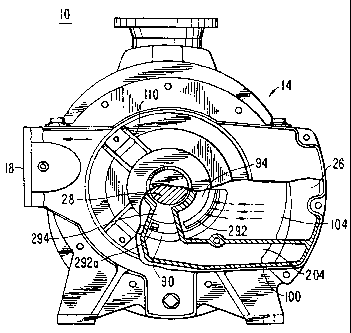Some of the information on this Web page has been provided by external sources. The Government of Canada is not responsible for the accuracy, reliability or currency of the information supplied by external sources. Users wishing to rely upon this information should consult directly with the source of the information. Content provided by external sources is not subject to official languages, privacy and accessibility requirements.
Any discrepancies in the text and image of the Claims and Abstract are due to differing posting times. Text of the Claims and Abstract are posted:
| (12) Patent: | (11) CA 2226799 |
|---|---|
| (54) English Title: | TWO-STAGE LIQUID RING PUMPS |
| (54) French Title: | POMPES A DEUX ETAGES A ANNEAU LIQUIDE |
| Status: | Term Expired - Post Grant Beyond Limit |
| (51) International Patent Classification (IPC): |
|
|---|---|
| (72) Inventors : |
|
| (73) Owners : |
|
| (71) Applicants : |
|
| (74) Agent: | GOWLING WLG (CANADA) LLP |
| (74) Associate agent: | |
| (45) Issued: | 2007-09-25 |
| (22) Filed Date: | 1998-01-13 |
| (41) Open to Public Inspection: | 1998-07-30 |
| Examination requested: | 2002-10-23 |
| Availability of licence: | N/A |
| Dedicated to the Public: | N/A |
| (25) Language of filing: | English |
| Patent Cooperation Treaty (PCT): | No |
|---|
| (30) Application Priority Data: | ||||||
|---|---|---|---|---|---|---|
|
A two-stage liquid ring pump has an interstage structure which promotes separation of the gas and liquid discharged from the first stage. The second stage has separate gas and liquid inlets for respectively admitting the separated gas and liquid to the second stage. This avoids any possible choking of the second stage gas inlet by liquid, thereby improving the performance of the pump.
La pompe annulaire à deux étages pour liquide a une structure qui favorise la séparation des gaz et des liquides déchargés du premier étage. Le deuxième étage est pourvu d'orifices d'admission séparés des gaz et des liquides. Cela évite l'étranglement par un liquide de l'orifice d'admission des gaz du deuxième étage, d'où de meilleures performances de la pompe.
Note: Claims are shown in the official language in which they were submitted.
Note: Descriptions are shown in the official language in which they were submitted.

2024-08-01:As part of the Next Generation Patents (NGP) transition, the Canadian Patents Database (CPD) now contains a more detailed Event History, which replicates the Event Log of our new back-office solution.
Please note that "Inactive:" events refers to events no longer in use in our new back-office solution.
For a clearer understanding of the status of the application/patent presented on this page, the site Disclaimer , as well as the definitions for Patent , Event History , Maintenance Fee and Payment History should be consulted.
| Description | Date |
|---|---|
| Inactive: Expired (new Act pat) | 2018-01-13 |
| Inactive: Late MF processed | 2008-01-18 |
| Letter Sent | 2008-01-14 |
| Grant by Issuance | 2007-09-25 |
| Inactive: Cover page published | 2007-09-24 |
| Letter Sent | 2007-07-17 |
| Inactive: Single transfer | 2007-07-05 |
| Pre-grant | 2007-07-05 |
| Inactive: Final fee received | 2007-07-05 |
| Notice of Allowance is Issued | 2007-04-26 |
| Letter Sent | 2007-04-26 |
| Notice of Allowance is Issued | 2007-04-26 |
| Inactive: Approved for allowance (AFA) | 2007-04-12 |
| Amendment Received - Voluntary Amendment | 2006-08-22 |
| Inactive: S.30(2) Rules - Examiner requisition | 2006-03-29 |
| Inactive: IPC from MCD | 2006-03-12 |
| Amendment Received - Voluntary Amendment | 2006-01-13 |
| Inactive: S.30(2) Rules - Examiner requisition | 2005-07-14 |
| Letter Sent | 2003-02-12 |
| Amendment Received - Voluntary Amendment | 2003-01-10 |
| Letter Sent | 2002-11-22 |
| Request for Examination Received | 2002-10-23 |
| Request for Examination Requirements Determined Compliant | 2002-10-23 |
| All Requirements for Examination Determined Compliant | 2002-10-23 |
| Application Published (Open to Public Inspection) | 1998-07-30 |
| Inactive: First IPC assigned | 1998-04-30 |
| Classification Modified | 1998-04-30 |
| Inactive: IPC assigned | 1998-04-30 |
| Inactive: IPC assigned | 1998-04-30 |
| Inactive: Filing certificate - No RFE (English) | 1998-04-06 |
| Application Received - Regular National | 1998-04-04 |
There is no abandonment history.
The last payment was received on 2007-01-03
Note : If the full payment has not been received on or before the date indicated, a further fee may be required which may be one of the following
Patent fees are adjusted on the 1st of January every year. The amounts above are the current amounts if received by December 31 of the current year.
Please refer to the CIPO
Patent Fees
web page to see all current fee amounts.
Note: Records showing the ownership history in alphabetical order.
| Current Owners on Record |
|---|
| GARDNER DENVER NASH LLC |
| Past Owners on Record |
|---|
| CARL G. DUDECK |
| RAMESH B. SHENOI |